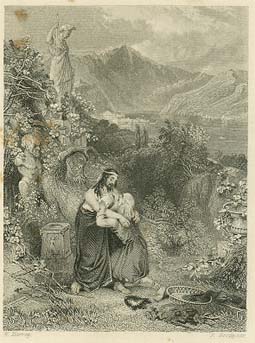Shadows and Tones
CASE 3
Culture and International Relations in the 18th Century
Copper engraving enables an artist to achieve detailed, realistic effects, which made it a suitable medium for reproducing European paintings in styles developed during and after the Renaissance, as these paintings typically used light and shade for realistic effects.
For example, presented here is a print made from an 1854 edition of William Cowper’s (pronounced “cooper”) poems. The engravings imitate the effects of painting. Most European artists of that time still subscribed to the idea that the central aim of art was “imitation,” that is, imitating the appearances of the real world, and “improving” those appearances by portraying things in a more beautiful and ideal manner. Therefore, both the painter and the engraver would have attempted to capture not the artist’s emotions but the emotions of the figures illustrated in the scene. This scene, for instance, illustrates the Biblical story of “The Prodigal Son,” the son who squandered his inheritance but was welcomed back by his father once he had asked for forgiveness. By manipulating the gestures of the two figures, and especially by controlling the light and tone of the scene, the artist was able to convey the emotions of a loving father greeting his long-lost son.
If we look at this same print at close range, we can see clearly how the artist created darker tones by making broader and deeper cuts into the copper plate. But, now the smooth flesh tones seen from a distance appear as odd-shaped dots. The cloth that seemed full of volume from a distance now dissolves into a series of stripes. For these various reasons, copper engravings were not generally meant to be seen at close range. The aim of art was illusion, which was achieved when viewed from a distance.



